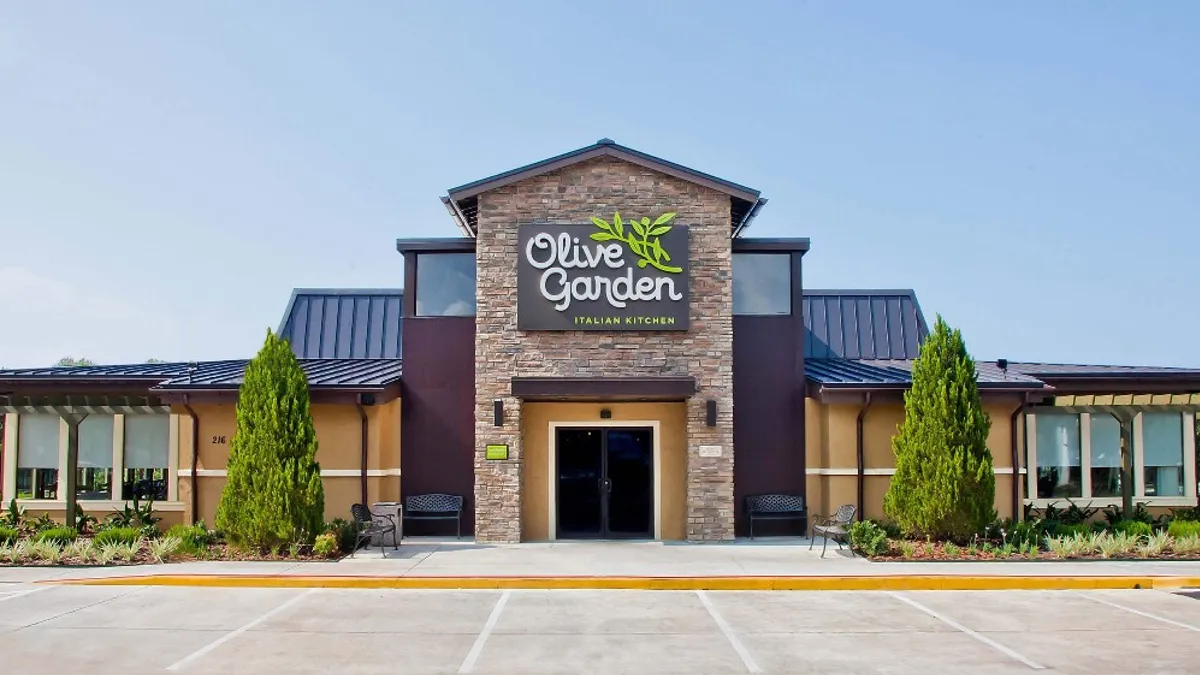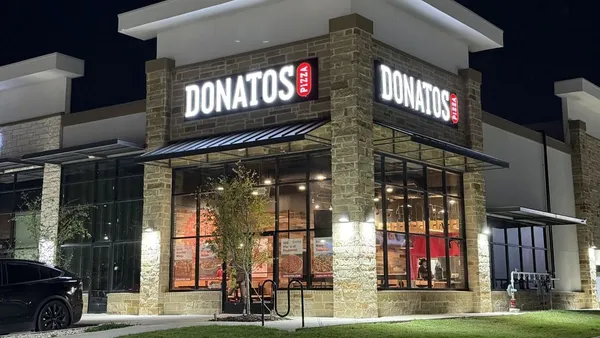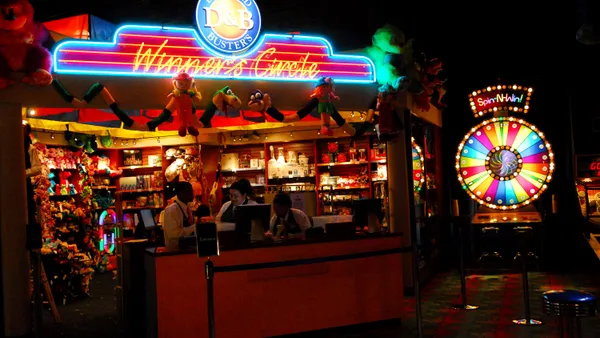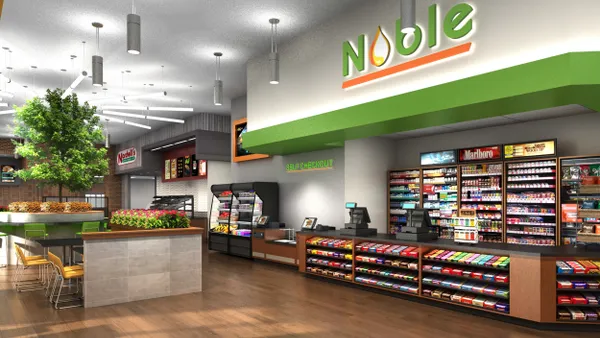After restaurant comp sales declined nearly 54% in April and recovered to a negative 15% in July, according to Black Box Intelligence data shared during recent Restaurant Rise webinars, the industry has been slowly recouping losses sustained during the height of dining room closures. But recovery has been more stunted for casual dining chains, which reported high double-digit losses during the most recent financial quarter.
The restaurants that shifted quickly to takeout offerings — adding curbside, improving the online ordering experience, expanding into outdoor dining and offering more delivery partnerships — are reaping the benefits of sustained off-premise sales and improved dine-in sales into July and August.
"I think we can surmise that without these options, these restaurants would probably be doing even worse than they are," Sean Lansing, director of client strategy at Top Data, said. Top Data is part of Top Agency, which creates market research and studies.
Chains are also focusing on value and trimming their menus to highlight more popular items. Top Data, which used data from Cuebiq, found that restaurants like Olive Garden and Texas Roadhouse that are known for their free supplies of bread have been the most visited during COVID-19.
As dining rooms began to reopen in May, casual dining comp sales started to recover, improving to a negative 21.2% in July, according to Black Box data, compared to a negative 49% in May. But bringing foot traffic back to 2019 levels will continue to be a battle, with casual dining traffic down 40% as of Aug. 1 compared to fast food traffic, which was down over 20%, according to Top Data.
What is likely to improve sales is increased efforts across every casual dining brand to train staff on proper health and safety techniques, social distancing of tables and ongoing cleaning standards. Casual dining chains had the highest cleanliness sentiment at 64% positive guest reactions in July, according to Black Box Intelligence.
"Every restaurant has had to adopt," Lansing said. "I don’t know that we’re going back to … the old normal."
To better understand the impact COVID-19 has had on various casual dining chains, Restaurant Dive took a closer look at some of the largest publicly traded casual restaurants and how their strategies have evolved during the most recent fiscal quarter.
Applebee's (Dine Brands)
Q2 comparable sales: -49.4%
Top three strategies:
- Discontinued all national marketing during a self-imposed media hiatus through Q2, returning with a digital media plan in mid-June
- Reduced its core menu that resulted in simplified operations, better execution and reduced food and labor costs
- Continued focus on off-premise sales, which accounted for 60.5% of its sales mix during Q2 compared to 16.3% in Q1, and leveraging the company’s digital sales to boost online ordering
The big picture:
As dining rooms began to reopen across the country, Applebee’s shifted its marketing focus to one that welcomes back guests to its dining rooms, while also continuing its off-premise messaging, John Cywinski, Applebee’s president, said during an earnings call. The company reintroduced Applebee’s to America with a new ad during the summer, which has received positive feedback, Cywinski said.
Dine-in represented 64% of volume while off-premise was 36% of sales in July, Cywinski said. Carside to-go made up 68% of off-premise while delivery made up 32%. The company is also holding on to most of its off-premise business amid dining room reopenings, with only about a 15% to 20% cannibalization rate, Cywinski said. Online to-go sales also grew to make up almost 23% of sales during Q2 compared to 5.1% of sales in Q1.
BJ's Restaurant
Q2 comparable sales: -57.2%
Top three strategies:
- Expanded outdoor dining space to almost 150 restaurants with 70% operating with dine-in as of late July
- Reduced menu from around 145 items to about 85, allowing managers to run restaurants more efficiently, and created an off-premise-friendly menu with affordable price points
- Placed greater emphasis on technology with the addition of QR codes for menu browsing and mobile payment, implementation of a reservation system to accommodate limited dining room capacity, as well as the addition of contactless curbside pickup with texting and email technology to allow guests to receive notifications about their orders
The big picture:
Technology will continue to be a bigger focus for the company as it finds ways to better engage with customers and streamline the ordering process. Greg Trojan, BJ’s Restaurant CEO, told investors the chain has been an early adopter of dining room and digital consumer technology. In 2019, for example, it tested dine-in, pre-ordering technology with Allset, in which consumers could reserve a table, order a meal and pay the check before arriving at the restaurant.
Off-premise and outdoor dining will also be key strategies for the chain, especially with off-premise growing three-fold by the end of April to over $30,000 in weekly sales, Trojan said. Outdoor dining also helped BJ’s boost its average weekly sales, which reached the low- to mid-$60,000 range as of late July even after dining rooms reclosed in California, Trojan said.
The Cheesecake Factory
Q2 comparable sales: -56.9%
Top three strategies:
- Upgraded technology, including contactless menu and payment technology and text paging
- Focused heavily on off-premise, along with an expansion of outdoor dining, especially at restaurants with large patios
- Targeted marketing efforts which were mostly focused on the off-premise channel, including a Fourth of July burger offer that generated over 4 billion media impressions
The big picture:
Since reopening began, Cheesecake Factory has maintained on average 90% of its elevated COVID off-premise sales levels with reopened restaurants, David Gordon, president of The Cheesecake Factory, said during an earnings call. Off-premise has also contributed to its recapture on average quarter-to-date of nearly 80% of prior year sales levels at these reopened restaurants, equating to over $8 million per unit on average. Off-premise-only restaurants are also performing well, with an average per unit of $4.2 million, Gordon said.
While other chains pulled back on marketing efforts, Cheesecake Factory did not. Its marketing focus on off-premise, especially its Fourth of July promotion, saw a majority of its sales from online ordering, which also made up 40% of its off-premise sales with delivery contributing 35%, Gordon said.
Chili's (Brinker International)
Q4 comparable sales: -32.2%
Top three strategies:
- Leveraged past technology investments to build up off-premise sales
- Switched its marketing focus from national TV spots to digital to emphasize its e-commerce platform, which helped drive digital sales up from the low-teens to over 50% of off-premise sales in Q4
- Expanded its virtual brand, It’s Just Wings, through a partnership with DoorDash, which launched in 1,050 restaurants on June 23
The big picture:
Over the last decade, Chili’s made investments to build its digital infrastructure, improve connection with guests and create ways to quickly respond to evolving dining needs, Wyman Roberts, Brinker International CEO and president, said during an earnings call. These investments have allowed the company to gain check-level purchasing insights from table top devices, improve its app with features like one-tap reorder and build its loyalty database to over 8 million members.
"We had already made significant progress in the areas required to thrive in this environment: off-premise, digital, value and scale," Roberts said. "We didn't have to scramble in the pandemic hit."
The addition of a virtual brand, It’s Just Wings, is also making headway and could exceed $150 million in sales in the brand’s first year, he said.
"Over the years, casual dining has been dinged for being overbuilt," Roberts said. "We believe this is our opportunity to prove that maybe it isn't overbuilt, it's just underutilized. It's Just Wings leverages existing buildings, equipment and labor."
The company is testing additional virtual concepts and learning how to drive visibility among DoorDash’s millions of customers, Roberts said.
Chuy's
Q2 comparable sales: -39%
Top three strategies:
- Enhanced takeout and curbside pickup along with a delivery service through DoorDash
- Streamlined menu to feature reduced entrees while adding family meals and beverage kits
- Resuming its marketing efforts in Q4 to highlight value, convenience and safety
The big picture:
While it focused on growing off-premise sales, which made up 60% of the company’s total revenue during Q2, it also pushed to reduce costs, furloughing a substantial amount of its hourly employees and management when the company switched to off-premise only, Jon Howie, vice president and chief financial officer, said during an earnings call. Labor costs decreased 790 basis points to make up 26.4% of costs.
To keep costs down, it reduced the number of managers to four per store during dining room shutdowns. When things began to reopen, it evaluated how many they would need per store going forward, Howie said.
The company is also evaluating some of its menu items and plans to reduce items in the future, which will ease operations as well, Steve Hislop, Chuy’s president and CEO, said during the call.
Darden
Q4 comparable sales: -47.7%
Top three strategies:
- Invested in team members by adding permanent paid sick leave and creating a three-week emergency pay program that provided nearly $75 million of pay during the fourth quarter for hourly staff that couldn’t work
- Strengthened its digital platforms by using technology to allow guests to more easily order outside and inside the restaurant, to improve the wait to be seated, to streamline the pickup process and to speed up how customers pay
- Built on its online ordering platform to support increased demand, including developing contactless curbside pickup
The big picture:
Darden made significant investments in its team members throughout the pandemic, offering to cover insurance payments and benefit deductions for furloughed team members, Gene Lee, Darden CEO, said during an earnings call with investors. For staff that came back to help support growing to-go operations, the company provided pay for unexpected costs like transportation and child care, he said. The company also paid target bonuses to managers during the fourth quarter, Lee said.
"Not only were these investments the right thing to do to take care of our team members, they've also created a deeper loyalty and strengthened engagement, while we've seen this pay off as we bring our people back to work," Lee said.
The company has been able to keep the majority of its managers employed and has stayed connected with furloughed team members, which allowed it to bring people back quickly and get its dining rooms open safely, Lee said.
Technology has also been a big part of Darden’s ongoing strategies, especially with online ordering growing by over 300% at Olive Garden compared to the prior fiscal year, making up 58% of to-go sales. The company also rolled out online ordering to brands that didn’t yet offer it, while also adding the ability to order alcohol at brands in markets that allowed it, Lee said.
Denny's
Q2 comparable sales: -56.9%
Top three strategies:
- Focused on off-premise channels, including its Denny’s on Demand platform, free delivery promotions and curbside ordering while also using parking lots and sidewalks for outdoor dining
- Streamlined menus to feature more popular products and to allow for greater kitchen speed and efficiency
- Introduced family meal packs and continued to the evolve platform to include desserts and milkshakes along with popular Grand Slam burgers and chicken dinner meals that feed a family of four
The bigger picture:
Adding different off-premise channels helped double the company’s average weekly off-premise sales from $4,000 per week in February to about $7,900 in July, John Miller, Denny’s CEO, said during an earnings call. Of its sales mix during its latest quarterly results, 63% made up dine-in while 22% was dine-through, which included curbside delivery or sitting in a tent at a table in the parking lot, while 13% was third-party delivery, Miller said.
"The reality is that off-premise business has been really kind of the silver lining in a very dramatic pandemic situation," Robert Verostek, Denny’s senior vice president and chief financial officer, said during the call.
The chain also noticed a shift in its customer demographics, with takeout usage of 18 - to 24-year-olds up 40% versus Q1, while older customer usage is slightly down because they are most concerned about getting out, Miller said. Younger customers may not have been reached through typical forms of broadcast or media, Miller said, adding that they have taken to online ordering and pickup and sitting in the parking lot with colorful seating when a competitor down the street doesn’t offer it.
IHOP (Dine Brands)
Q2 comparable sales: -59.1%
Top three strategies:
- Discontinued marketing in the first quarter through the first three weeks of July except for basic local marketing and a brief off-premise campaign, restarting a national campaign July 22
- Continued focus on off-premise, which accounted for about 54% of sales mix for Q2 compared to 12.8% of the mix for Q1; Curbside pickup, which launched the week of March 29 and doubled to 6.3% of off-premise sales for the week ending April, reached 8% of off-premise sales for the week ending June 28
- Continued growth through traditional and nontraditional development, which Jay Johns, IHOP president, expects could grow market share following the permanent closure of independent restaurants
The bigger picture:
With more people staying home, off-premise increased 145% primarily driven by traffic, Johns told investors during an earnings call. Delivery sales were also strong, making up 23.4% of the sales mix while takeout accounted for 33.5% of sales during Q2. Online sales made up nearly 35% of sales in Q2 compared to about 7% in Q1.
"We believe our collective off-premise initiatives will continue to drive sustainable growth as more people are utilizing to-go now than before the pandemic," Johns said. "As a result a wider range of guests are familiar with the ease and convenience of having their favorite IHOP meals to pick up or be delivered."
The One Group
Q2 comparable sales: -81.4% (STK); -52.8% (Kona Grill)
Top three strategies:
- Built core competencies in curbside and delivery, including upgrading tech capabilities to allow offerings through nine delivery providers
- For Kona Grill, offering new menus, aggressive and sustained marketing activities, including a summer fun promotion
- Leveraged loyalty programs for both STK and Kona Grill to deploy various email campaigns and using targeted social media
The big picture:
The One Group has pushed for diversification within its offerings during the pandemic. That has included launching an e-commerce platform in April so guests can purchase choice, prime and wagyu steak cuts for home delivery nationwide, which could be continued even after the pandemic subsides, Manny Hilario, CEO of The One Group, told investors during an earnings call. These kits cost $25 to $30 and can be sent with two- to three-day delivery.
Takeout and delivery has consistently grown from the end of Q1 to Q2 and makes up 14% of the company’s total revenue, Tyler Loy, chief financial officer of The One Group, said. Prior to COVID-19, takeout/delivery made up about 5% of the company’s total business, Hilario said. The company plans to continue to grow this business substantially and has already been adapting its menus, such as making STK’s items more transportable, Hilario said.
Kona Grill’s suburban footprint has also benefited from people in their mid-30s coming back out because they want to get out of the house, Hilario said. The brand has been reviving its bar and patio program already with more active music and an emphasis on better cocktails, he said.
Outback Steakhouse (Bloomin' Brands)
Q2 comparable sales: -32.9%
Top three strategies:
- Revised its online ordering platform to enhance stability and performance and implemented tools to pursue targeted digital marketing efforts
- Reduced complexity and improving consistency and profitability across all revenue streams by looking at all areas of the business such as menu optimization, enhancing the labor model and finding ways to better support restaurants
- Opted not to furlough or lay off any employees, which allowed restaurants to be better prepared to reopen dining rooms safely
The big picture:
Rapid growth of off-premise sales allowed Outback parent company Bloomin’ Brands to keep a substantial number of its locations open during the dining room closures, David Deno, Bloomin’ Brands CEO, said during a July earnings call. Even as fewer Outback restaurants operated with off-premise only into June and July as dining rooms reopened, average sales continued to grow, reaching $43,462 by the week ending July 19 compared to $42,140 by week the ending June 21, according to an earnings release.
Prior to COVID-19, the company was doing about $10 million a week in total off-premise sales, which peaked at about $32 million in sales in April before dining rooms reopened, Chris Meyer, Bloomin’s Brands executive vice president and chief financial officer, said during a call with investors. By mid-July, the company was making $23 million in off-premise sales a week on $52 million in total sales, Meyer said.
"We will continue to leverage our strong capabilities to retain the off-premises growth we achieved during the pandemic," Deno said. "Off-premises remains a large opportunity and a significant part of the go-forward strategy."
Red Robin
Q2 comparable sales: -41.4%
Top three strategies:
- Focused on all off-premise channels of carryout, third-party and Red Robin Delivery while enhancing technology and digital capacities into 2021 and beyond
- Accelerated the implementation of its total guest experience, the company’s new hospitality model, as dining rooms reopened to improve the guest experience
- Resuming the rollout of Donatos Pizza at over two dozen restaurants before the end of the year
The big picture:
As part of its off-premise strategy, the chain rolled out a simplified menu with one-third fewer items and refined its operating processes, Paul Murphy, CEO of Red Robin, told investors during an earnings call. The shorter menu improved ticket times, consistency and food quality and created better back-of-house efficiencies, Murphy said. Additionally, the company dedicated additional space for order assembly and implemented improvements to make promised times more accurate, he said. These strategies seemed to work. During Q2, off-premise sales increased over 208% and represented nearly 64% of total food and beverage sales, according to an earnings release.
The company’s digital channels, including online ordering through its website and third-party marketplaces, made up about 80% of the company’s off-premise sales. The company plans to refine its restaurant prototype in 2021 to better balance the execution of off-premise and dine-in channels in a post-pandemic environment.
Its new hospitality model, which was planned pre-COVID-19, also helped the company reach record high dine-in guest satisfaction scores, Murphy said. The operational enhancements have led the company to expand its outdoor seating beyond its patios to the majority of its system, including California, where dining rooms were reclosed, he said. The company is also testing the implementation of partitions inside restaurants, Murphy said.
Donatos Pizza is expected to offer a high return on investment, considering the 48 restaurants that added the pizza options before the pandemic outperformed restaurants without it by 700 basis points, Murphy said. The company expects to roll out Donatos to 31 Seattle restaurants by the end of the year as a majority of the equipment was already purchased pre-COVID-19, he said.
Ruth's Hospitality
Q2 comparable sales: -74%
Top three strategies:
- Launched online ordering and payment at company restaurants and added multiple third-party delivery partners
- Streamlined menu choices and refined to-go packaging to provide quality and reheating capabilities
- Revised the dining room experience by offering dinner and wine menus via QR codes, personal side options and limiting the number of people at each table
The big picture:
The casual chain, which relies heavily on its dine-in experience, took a huge hit in April when comparable sales declined 87% and no dining rooms were open. Since then, the company repurposed some of its private dining rooms into main dining room use and is working to provide additional capacity with appropriate social distancing inside and outside the restaurant, Cheryl Henry, CEO at Ruth’s Hospitality, told investors during an earnings call.
The company will continue to provide a broad set of dining dining options, including full-service dining rooms, outdoor seating and dining in bars where possible and ongoing off-premise offerings, Henry said.
Dining room business made up over 80% of average weekly sales in June while off-premise was about 10% to 15%, Arne Haak, executive vice president and chief financial officer of Ruth’s Hospitality, said.
"You definitely see the off-premises sales drop when the territories open up for in-dining restaurant[s]," Haak said. "But it's still there, and there's certainly still some people that I think feel more comfortable eating off-premises."
Texas Roadhouse
Q2 comparable sales: -32.8% (company-owned); 32.1% (franchise-owned)
Top three strategies:
- Pivoted to to-go sales in March with curbside pickup options
- Implemented outdoor dining and dine-in and enhanced to-go models in May and June
- Revamping its building prototype with more dedicated space for to-go operations
The big picture:
While off-premise made up nearly 42% of weekly sales in May, the mix has held steady at about 25% throughout July, according to an earnings release. The company is also working on potential changes to its building prototype that could better enhance its ability to handle higher to-go sales, especially with the expectation that uncertainty and volatility will remain into the coming months and quarters, Kent Taylor, CEO of Texas Roadhouse, told investors during an earnings call. These changes could include using excess waiting areas to create more space for to-go curbside and a place to store more to-go supplies, he said.
The company is also looking at different technologies to make to-go transactions easier and to reduce the labor needs of off-premise operations, Tonya Robinson, chief financial officer at Texas Roadhouse, said.














